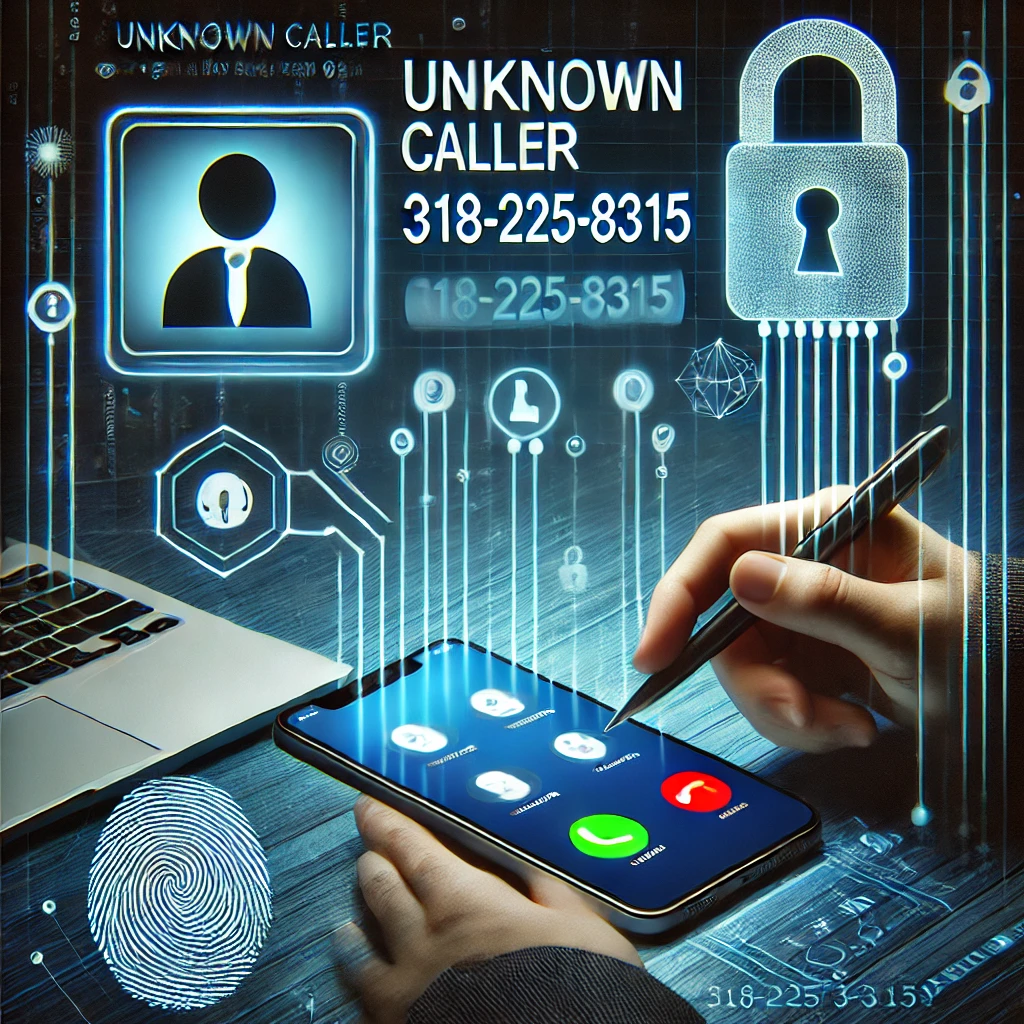
Introduction
Therefore, it is important to learn to trace unknown callers such as 318-225-8315 and take up some protective measures so that your personal information remains protected and, hence, you can live a stress-free life. In modern life, it is common to receive calls from an unknown number. Some are harmless while other pose threats such as scams and invaders of privacy.
What Unknown Callers Are
Trace Unknown Callers is typically one that by intent chooses to conceal their identity by withholding their phone number or showing it as “No Caller ID.” This anonymity can be achieved in various ways, such as turning on specific phone settings or using third-party applications.
Reasons Why Unknown Calls Are Made
There are several reasons why you could receive calls from unknown numbers:
Telemarketing: Selling products or services.
Scams: Fraudsters seek to obtain personal information or money.
Prank Calls: A person simply makes a call for fun with no bad or evil intentions.
Legitimate Use: Calls from certain institutions like hospitals or government agencies that may not show caller ID.
Risks Related to Trace Unknown Callers
Receiving calls from unknown callers can expose you to various risks, such as:
Loss of Money: Getting duped by scams to provide your financial information.
Identity Theft: Sharing your personal details that can be used for illegal purposes.
Harassment: Receiving repeated nuisance calls that cause emotional distress or fear.
How to Trace Unknown Callers
Using Reverse Phone Lookup Services
Reverse phone lookup services allow you to enter a phone number and find out who the caller is. Some examples are Whitepages and Truecaller, which provide details like the name, location, and whether the number has been marked for spam.
Using Spam Identification Apps
These applications that identify and block spam calls are most useful when it comes to dealing with unknown callers. They comprise Truecaller, Hiya, and more, which identify callers and customers.
Contact Your Phone Provider
Your phone provider may have services which help trace or block unknown callers. Calling their customer support allows one to inquire about features such as rejecting anonymous calls or tracing calls.
*Return Call Codes (69)
In some areas, by dialing *69 straight after receiving an unknown call, one is connected to the previous incoming number. Such services may be chargable and not available in all areas, making it good for a double-check to ask from the service provider.
Phones and Apps for Identifying the Trace Unknown Callers
An Overview of Truecaller
Truecaller is globally recognized to identify unknown callers and blocks spam calls and messages. With a huge database on phone numbers, it allows users to view caller ID even if the number is not saved in contacts.
Features of Hiya Caller ID and Block
Hiya provides real-time spam detection and caller ID, along with various call-blocking features. It gives users some background about the incoming caller, enabling them to answer or ignore the call.
Pros of Using Nomorobo
Nomorobo is an anti-robocall software for VoIP landlines and mobile phones. It prevents unwanted calls from reaching you using a large database of known robocall numbers.
The Effectiveness of TrapCall
TrapCall offers an amazing app feature that allows the user to unblock numbers by revealing the number of the caller as long as it’s unknown. In the same vein, they also have features to block spam calls and the ability to record incoming calls for extra security.
Self-Protection Measures against Unwanted Calls
Registering with the National Do Not Call Registry
In the USA, registering your number with the National Do Not Call Registry should reduce telemarketing calls; it would not prevent all calls, but it will significantly minimize the number of such calls.
Blocking Numbers on Your iPhone and Android Phones
Your iPhone and Android phones come built-in with the facilities of blocking selected numbers.
iPhone: Bring up your recent calls list, tap the “i” next to the number, and select “Block this Caller.”
Android: Go to your call log, tap the number, and select “Block” or “Report as spam.”
Using Built-in Phone Features to Silence Unknown Callers
Most mobile phones have features to silence unknown callers automatically.
iPhone: The Silence Trace Unknown Callers feature will send callers you don’t know straight to voicemail. This can be enabled from Settings > Phone > Silence Unknown Callers.
Android: Certain Android devices have similar features under Phone Settings > Caller ID & Spam Protection.
This is a great option if you want to focus without being disturbed, while still allowing serious calls to go to voicemail.
Implementing Third-Party Call Blocking Apps
Apart from the built-in features, third-party apps enhance your protection. Some of the best options are,
Truecaller (Truecaller.com) – Provides caller IDs and blocks spam calls.
Hiya (Hiya.com) – Real-time alerts on spam calls.
Nomorobo (Nomorobo.com) – Blocks robocalls — both VoIP and mobile numbers.
RoboKiller (Robokiller.com) – Uses AI to anticipate spam calls before they reach you.
These apps are being constantly updated with the known numbers of spam and scam calls presenting an enhanced measure of protection.
Recognizing and Avoiding Scams
Many unknown callers are legitimate, but it’s crucial for you to be aware of the red flags.
Common Phone Scams to Watch out for
IRS or Tax Scam – Someone claiming that you owe them taxes and threatening you with lawsuits if you don’t pay now.
Tech Support Scam – Fake tech support representatives are asking you to allow remote access to your computer or phone.
Lottery or Prize Scams – “You won this enormous raffle! Get a fistful of cash! But wait!, you will have to pay certain last-minute fees to claim your reward!”
Bank Fraud Alert Scams – Some impostor calling you from your unseen bank, wanting you to divulge your most secret information to determine whether there is some fraudulent activity on your account.
Fake Charity Calls – Charitable organizations calling for monetary donations may be scams run by impostors.
Red Flags That Indicate a Scam Call
The caller urges you to do something quickly.
They ask for your personal or financial information.
The caller forces you to pay through gift cards or wire transfers.
The number is hidden or shown as “No Caller ID.”
What to Do If You Suspect a Scam
Do not engage – Once you sense whatever red flags are raised, disengage.
Never give any information – Don’t even confirm your name.
Reverse lookup – Use services like WhoCallsMe or Spokeo to check the number.
Report the call – If implicated, report the scam on the FTC website.
Notify the Authorities About Scam Calls
In the USA, report to the FTC (reportfraud.ftc.gov).
In the UK, notify Action Fraud (actionfraud.police.uk).
In India, file a complaint through Cyber Crime Portal (cybercrime.gov.in).
Reporting
Know-your-rights help you pursue those unwanted callers.
Understanding Rights Protecting Individuals Against Spam Calls
In the USA, the Telephone Consumer Protection Act (TCPA) restricts telemarketing calls.
In the UK, the privacy and electronic communication regulations (PECR) regulate unwanted marketing calls.
In India, telecom commercial communication customer preference regulation (TCCCPR) allows blocking of telemarketing calls.
Lodging Complaints with the FCC
When for any reason you are situated in the USA, report to the FCC through FCC Complaints.
What Actions can be Taken Against Harassing Callers
Cease and desist letter to send them a warning.
Fundamental harassing charges may be taken–a civil case may arise.
A tort or civil lawsuit for compensations may arise when a firm openly violates privacy acts.
Educating the Most Vulnerable
Certain populations are far more vulnerable to phone scams than others.
Educating Seniors About Phone Scams
Scam strategies continue to target seniors the widest. Family members must:
Always discourage children from talking answers to unknown callers.
Educate them not to answer calls from numbers they recognize.
Educate them on their phones about some apps like Norton Family, Life360, or Qustodio.
Protect children from unwanted calls.
Innocently, a child may share personal information. A parent should:
Set up call restrictions on the child’s phone.
Teach them not to answer unknown numbers.
Set up parental control apps, for example: Rogue Killer, Hiya Protect.
Information Material for Non-English Speakers.
The number of internationally available scam training materials is massive and available in various languages. The FTC will translate these in the U.S.A. for consumer.ftc.gov.
Technological Advances in Call ID
With advancing technology, unwanted calls are being countered with advanced technological inventions.
Using Artificial Intelligence to Identify Calls
AI-driven applications like Robokiller and Hiya Protect use training to ascertain new scam patterns.
The Role of Telecoms in Stopping Spam Calls
Many telecom companies provide network-based spam filtering. Following are some examples:
Scam Shield, offered by T-Mobile; Call Protect, offered by AT&T; Call Filter, offered by Verizon
Future Trends in Call Blocking Technology
AI will identify and block calls in real-time.
Biometric caller authentication will wipe out the problem of fraud.
Stricter international regulations will hamper unwanted calls on the networks.
5G will cause many security issues in making calls.
The next challenge to tackle in call security comes with the benefit of communication speed that comes with 5G. To contain spoofing, everything will change once applied on this vast scale, whereby a researcher is occupied with many things to come, like creating new encryption methods.
Case Study: Real-Life Cases of Learners
People Successfully Identifying Unknown Callers
Many individuals have successfully identified the unidentified callers as possible scams using Truecaller or government databases.
Things Phishing Phone Scam Victims Have in Common
Some of the common things that victims shared are: Their reports contain the following stupid things: answering the calls of unknown numbers; believing in some sort of threats from an agency; mentioning some highly sensitive information over a phone. How industries deal with unwanted calls?
The more the world of business shifts toward automated call screening for a cut in spam, the more enterprises prefer to block calls in greater detail.
Psychological Aspects of Calling Scammers
Scammers usually coerce their victims into cooperating through fear induction or fear of fabricated authority. Some of the methods are scams you can easily avoid if you already recognize them.
Conclusion
Tracking unknown callers and protecting yourself from possible scams has become very critical within the present world of digitization. But with the use of reverse phone lookup services, call-blocking applications, and legal devices, the probability of harm from strange numbers like 318-225-8315 can be significantly minimized. Be vigilant, understand their scams, and make the best use of technology to protect your privacy.





